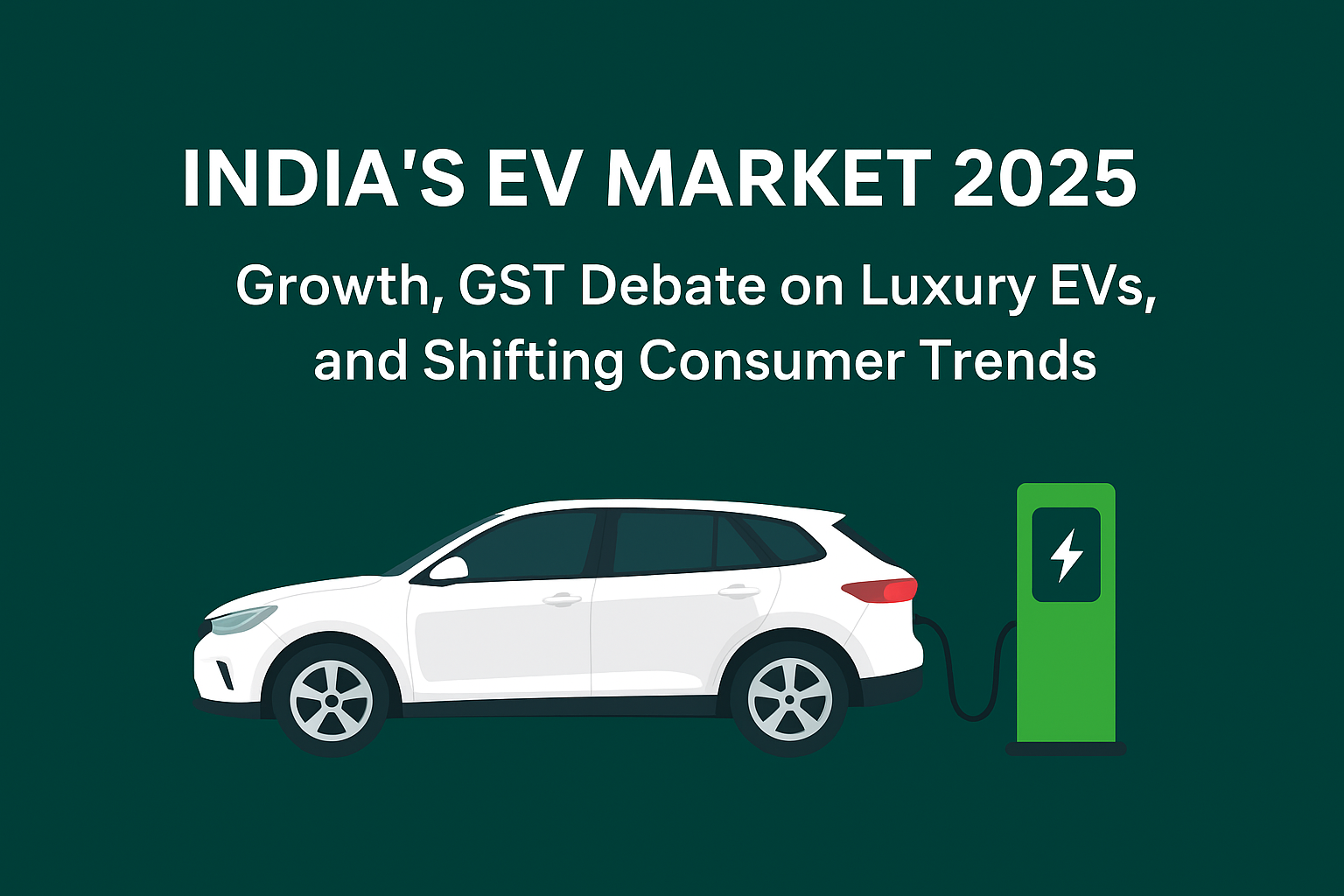India’s electric vehicle (EV) landscape is entering a decisive phase, with the government weighing a major tax reform. The Goods and Services Tax (GST) on premium EVs may rise sharply—from the current 5% to 18%. This potential hike represents more than just a fiscal adjustment; it touches on the core of India’s green mobility strategy.
The rationale is clear: by applying higher GST on luxury EVs, policymakers hope to preserve incentives for mass-market electric cars and two-wheelers, keeping them affordable for everyday consumers. At the same time, the government could redirect revenue from premium segments toward subsidies, battery research, and charging infrastructure expansion—areas critical to sustaining long-term adoption.
Yet, this shift also opens a deeper debate. Can India balance inclusivity with differentiation in its EV market? For a country where adoption is still at an early stage, the risk is that higher taxation on premium EVs may discourage innovation, dampen aspirational buying, and potentially slow the momentum toward electrification.
In effect, the GST proposal highlights a pivotal question: should India push for uniform affordability to accelerate adoption, or should it create a two-tier system—keeping entry-level EVs accessible while expecting higher contributions from luxury buyers?
Why Premium EVs Might Face Higher GST
For years, India has kept electric vehicles under a favorable tax regime to encourage adoption. At present, EVs—including two-wheelers, four-wheelers, and even electric buses—are taxed at just 5% GST, one of the lowest slabs in the automobile sector. This policy has helped reduce entry barriers and nurture early adoption in a price-sensitive market.
However, a recent draft recommendation by the Group of Ministers (GoM) proposes a major change: premium EVs priced above ₹20 lakh could be moved into the 18% GST bracket. The logic is straightforward but controversial—while mass-market EVs need affordability to accelerate penetration, luxury EVs can sustain a higher tax burden. Revenue generated from this adjustment could then be funneled into battery research, charging infrastructure, and subsidies for affordable EVs—the backbone of India’s long-term green mobility strategy.
Experts believe this marks a clear policy shift from blanket incentivization toward targeted taxation, ensuring resources are used where adoption gaps remain widest.
EV Adoption and Market Trends in India
India’s EV market has grown rapidly in recent years, driven by rising fuel prices, policy incentives, and an expanding charging network. Yet, affordability remains the single largest factor influencing purchase decisions.
Here’s how the market is shaping up as of FY 2024–25:
| Metric | Value |
|---|---|
| Total EV sales (FY 2024–25) | Over 2.03 million units (16–17% YoY growth) |
| 4-Wheeler EV growth | Around 15% increase year-on-year |
| EV share of passenger vehicles | 4% by May 2025 |
Despite this progress, premium EVs continue to face resistance. Unlike budget-friendly models—where incentives make ownership cost-competitive with petrol or diesel vehicles—luxury EVs already cater to wealthier buyers less sensitive to upfront cost. Raising taxes on this segment is unlikely to stall the industry’s momentum, but it could slow luxury EV sales while redirecting policy benefits toward middle-class consumers.
At the same time, automakers warn that any disruption in the premium category could spill over into consumer sentiment, affecting how EVs are perceived as a whole. A higher tax rate might signal that EVs are not as universally supported as before, potentially dampening long-term enthusiasm.
EV Adoption and Market Trends in India
India’s electric vehicle (EV) sector is moving through its fastest growth phase yet, fueled by high fuel prices, supportive government incentives, and gradual improvements in charging infrastructure. But one factor continues to dominate purchase decisions: affordability.
As of FY 2024–25, the Indian EV market looks like this:
| Metric | Value (FY 2024–25) |
|---|---|
| Total EV sales | Over 2.03 million units (16–17% YoY growth) |
| 4-Wheeler EV growth | Around 15% increase year-on-year |
| EV share of passenger vehicles | ~4% by May 2025 |
This data highlights a key divide: while overall EV penetration is improving, premium EVs continue to lag behind. Budget-friendly models—particularly two-wheelers and compact cars—are reaping the benefits of incentives and in many cases are cost-competitive with petrol or diesel alternatives.
By contrast, luxury EVs appeal to a smaller base of wealthy buyers, a group far less sensitive to fuel prices or subsidies. Raising GST on these high-end EVs is unlikely to stall the industry’s momentum overall but will almost certainly cool luxury EV demand.
At the policy level, the idea is to redirect benefits toward middle-class consumers, who represent India’s largest untapped EV market. Yet, automakers are cautious. Some industry leaders argue that heavily taxing premium EVs may carry reputational risk. It could send a mixed message about the government’s long-term EV strategy, creating uncertainty for both manufacturers and consumers.
If buyers perceive that EVs are not universally supported, it could erode enthusiasm for the transition and slow the narrative of EVs as India’s “future of mobility.”
FAQs on EV Taxation and Market Trends in India
Q1. Why is India considering a higher GST rate for luxury EVs?
The proposed increase is not meant to discourage EV adoption overall but to balance subsidies. Policymakers want incentives to benefit the widest consumer base, particularly middle-income buyers. By taxing luxury EVs higher, the government can redirect funds toward infrastructure, mass adoption, and research initiatives that have broader impact.
Q2. Will a higher GST on premium EVs make them less competitive?
Yes, to an extent. Premium EVs already face higher costs due to imported components and advanced battery packs. A move from 5% to 18% GST could raise the on-road price by several lakhs, affecting competitiveness against luxury petrol or hybrid cars. However, buyers in this segment are generally less price-sensitive, so the slowdown may be moderate rather than dramatic.
Q3. How does India’s EV taxation compare with other countries?
Globally, many countries differentiate EV incentives based on price bands. For instance, the U.S. caps federal EV tax credits at certain MSRP thresholds, while countries like Germany and China provide higher subsidies for mass-market EVs than luxury ones. India’s proposed shift mirrors this global trend of targeting affordability and scale.
Q4. Could higher GST affect India’s EV manufacturing ecosystem?
Indirectly, yes. Premium EVs often act as a showcase for advanced technologies—like long-range batteries, autonomous features, or fast charging—that eventually trickle down into mass-market models. A heavier tax burden might discourage automakers from introducing such innovations quickly in India. That said, it could push manufacturers to focus more aggressively on affordable EVs, aligning with the government’s priority.
Q5. What does this mean for middle-class EV buyers?
If implemented, the change could work in their favor. Revenue from taxing luxury EVs might fund better charging infrastructure, wider subsidies for affordable cars, or financing programs for two-wheelers and compact EVs. This shift would strengthen adoption among first-time EV users, making ownership easier and more practical for the middle-income segment.
Q6. How big is the luxury EV market in India today?
Luxury EVs form only a fraction of the overall EV market, estimated at less than 2–3% of total sales. Brands like BMW, Mercedes-Benz, and Audi cater to high-income buyers, with sales in the thousands compared to millions of budget EVs. Thus, while the proposed tax might hit luxury brands harder, it won’t significantly disrupt overall EV penetration.
Q7. Could this policy affect India’s EV narrative globally?
Yes. India has positioned itself as an emerging EV hub, especially in the affordable segment. But if premium EVs face heavier taxes, global automakers might perceive the market as less attractive for luxury launches. This could delay the introduction of cutting-edge EVs, potentially slowing India’s reputation as a holistic EV destination.

